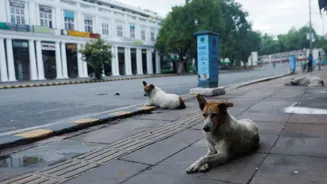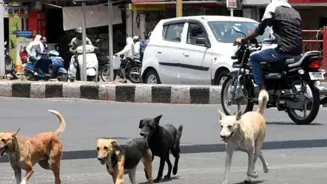The Supreme Court on Wednesday released a comprehensive written order elaborating on its August 11 verdict. This order provided detailed guidelines to ensure the welfare of captured stray dogs, highlighting
that these animals should never face mistreatment, cruelty, overcrowding, starvation, or neglect.
The detailed order was issued as the suo motu case concerning the stray dog menace was transferred from the bench of Justices JB Pardiwala and R Mahadevan to a new three-judge bench led by Justice Vikram Nath.
The court reiterated that all stray dogs in Delhi and the National Capital Region (NCR) must be promptly rounded up and housed in shelters, prohibiting their release back onto the streets. Authorities were instructed to prevent overcrowding and ensure continuous care for the animals.
The order mandated that dogs should not face mistreatment, cruelty, or substandard care. Civic agencies and personnel at dog shelters were directed to avoid overcrowding, maintain constant monitoring, and provide adequate, regular feeding.
Trained veterinarians are required to give timely medical care, and vulnerable or weak animals should be housed separately whenever possible. The written order also detailed minimum staffing standards, record-keeping, and identification procedures.
Authorities must ensure that at least two responsible personnel are present at shelters at all times, with a duty roster in place for round-the-clock supervision. All captured animals must be earmarked and logged for identification, with strict actions warned against any failure leading to a stray’s re-release.
The court acknowledged public concerns prompting its intervention and emphasised that the round-up exercise followed prolonged deliberation, not impulsive action. The court acted after concluding that there had been a systematic failure by authorities over the past two decades to address a public safety issue.
Balancing human safety with animal welfare, the court dismissed what it termed “virtue signalling” by some stakeholders, urging genuine supporters to volunteer in shelters. The directions were for the welfare of both humans and dogs, the court noted, calling upon the public and animal-welfare organisations to responsibly assist in running the shelters.
Regarding adoptions raised during the August 11 hearing, the written order authorised adoption schemes but only after rigorous vetting according to the Standard Protocol for Adoption of Community Animals dated May 17, 2022, from the Animal Welfare Board of India. Adoptions must ensure permanent rehoming without releasing animals back into public spaces.
The original oral order, now fully incorporated, had instructed authorities in Delhi, Noida, Ghaziabad, and Gurugram to establish shelters for at least 5,000 dogs within six to eight weeks and begin immediate capture operations.
The written version added Faridabad to the list and mandated a helpline for dog-bite complaints, ensuring offending animals are picked up within four hours. The bench warned that obstructing the capture programme would be treated as contempt of court.
The court criticised the Animal Birth Control rules that require sterilised animals to be released back into the same locality, questioning why sterilised animals should return to places where they continue to menace residents.
The detailed written order highlighted the court’s concern for vulnerable human groups like visually impaired persons, children, the elderly, and the homeless, who are especially at risk from dog attacks and have limited access to post-exposure treatment. The court emphasised that the law must safeguard the rights and security of every individual, particularly those at the margins.
The litigation began suo motu following media reports of a child’s death from rabies after a dog bite. The bench frequently cited alarming statistics on dog-bite incidents, especially involving infants and the elderly. The issue has sparked intense public debate, with divisions between animal-welfare advocates and residents’ associations, as well as among municipal officials tasked with implementation.
By explicitly codifying welfare standards and operational protocols, the court aims to ensure the stray dog round-up does not lead to abuse or neglect, while also addressing long-standing public safety concerns.
















